Sweeping changes to Batesville Deanery and NCYC top local news stories
By Brandon A. Evans
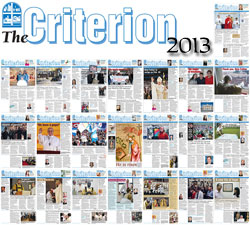 The multitude of changes that parishes in the Batesville Deanery saw as a result of the “Connected in the Spirit” parish planning process, Indianapolis hosting 23,000 youths at the National Catholic Youth Conference (NCYC), and local reaction to the resignation of Pope Benedict XVI and the election of Pope Francis were voted the top three local news stories of 2013.
The multitude of changes that parishes in the Batesville Deanery saw as a result of the “Connected in the Spirit” parish planning process, Indianapolis hosting 23,000 youths at the National Catholic Youth Conference (NCYC), and local reaction to the resignation of Pope Benedict XVI and the election of Pope Francis were voted the top three local news stories of 2013.
Other stories of note include coverage of Archbishop Joseph W. Tobin receiving his pallium from Pope Francis, a Madison family business winning a federal appeal against the Department of Health and Human Services (HHS) mandate, Marian University opening its school of osteopathic medicine and a record amount of money raised for Catholic education.
Working in the custom of other news agencies, The Criterion editorial staff votes each year for the top 10 local stories that were published in our newspaper.
Many of the stories selected this year were made up of several individual articles. Read this story online to browse the links to all of our original coverage.
Among the hundreds of locally produced news stories during 2013, here is our “Top 10” list:
1. Sweeping changes are announced and implemented for parishes in the Batesville Deanery
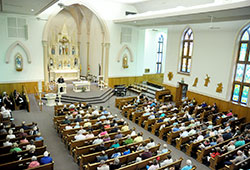 On June 6, Archbishop Joseph W. Tobin spoke before hundreds of people gathered at St. Louis Church in Batesville to announce a series of decisions that would affect 26 of the 27 parishes in the Batesville Deanery and three other nearby parishes.
On June 6, Archbishop Joseph W. Tobin spoke before hundreds of people gathered at St. Louis Church in Batesville to announce a series of decisions that would affect 26 of the 27 parishes in the Batesville Deanery and three other nearby parishes.
The decisions had been made as part of the ongoing “Connected in the Spirit” parish planning process which the deanery had been participating in for two years.
The result for the Batesville Deanery was that 12 parishes would close by Dec. 1 of this year; other parishes would be linked together in such a way that they would share a priest, other staff members and create joint programs, ministries and committees; still others would create partnerships to collaborate with nearby parishes.
Archbishop Tobin’s own childhood parish in Detroit was closed, and he said that he identifies with the pain and anger coming from some of the affected parishes.
“It’s not perfect, as no human process is entirely perfect. But I think it does favor—at least in the first stages—the impetus coming from the ground up rather than from the archbishop down. I think that’s really important. …Having worked in other dioceses that have gone through this sort of reconfiguration, it was much more of a top-down process in those other places.”
News coverage:
Related:
2. Indianapolis hosts 23,000 youths at NCYC
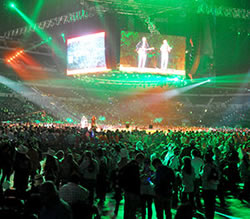 It’s no small feat to play host to more than 23,000 high school-aged Catholics from all over the country for a weekend. It’s even more impressive that this is the second time in the past two years that Indianapolis has hosted the biannual National Catholic Youth Conference (NCYC).
It’s no small feat to play host to more than 23,000 high school-aged Catholics from all over the country for a weekend. It’s even more impressive that this is the second time in the past two years that Indianapolis has hosted the biannual National Catholic Youth Conference (NCYC).
The three-day event is a chance for young people to come together and grow in the faith of Jesus Christ through worship, meeting new people, learning more about Catholic beliefs and celebrating the sacraments.
Archdiocesan staff, the National Federation for Catholic Youth Ministry and more than 600 local volunteers made the event a success.
The closing Mass featured Archbishop Tobin as the principal celebrant, joined by 12 bishops and 237 priests.
“I believe it’s safe to say that tonight we formed the national parish of the United States of America,” he said. “Can you recall another occasion when there are people from all 50 states gathered around the Lord’s table in word and his sacrament? I can’t.”
News coverage:
Related:
3. Archdiocesan Catholics respond to the resignation of Pope Benedict XVI and the election of Pope Francis
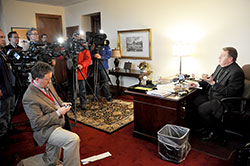 The resignation of Pope Benedict XVI—the first such resignation in nearly 600 years—made waves all around the world.
The resignation of Pope Benedict XVI—the first such resignation in nearly 600 years—made waves all around the world.
Catholics in the archdiocese reacted with a variety of emotions, and our news stories covered the spectrum as we talked to a number of people.
Franciscan Sister Maureen Irvin said that the decision offered a lesson in humility and hope. Nick Lesch, then a junior at Indiana University Purdue University in Indianapolis, said that the pope’s example has inspired him to work harder in his studies. Maxine Ferguson, 82, understands the challenges of aging and had admiration for his decision.
After the resignation became official on Feb. 28, the archdiocese joined the world in prayer for the election of a new pope—something that happened less than two weeks later.
Reaction to the election of Cardinal Jorge Mario Bergoglio of Buenos Aires, Argentina, as Pope Francis was immediate, and was covered in a number of stories in The Criterion.
“We rejoice that the Lord has given us this holy and learned figure to lead the Church,” Archbishop Tobin said. “And I know that everyone in the archdiocese joins me in promising our obedience and our cooperation to Pope Francis.”
News coverage:
- Pope Benedict XVI
- Conclave
- Pope Francis
Related:
4. Archbishop Tobin receives his pallium from Pope Francis
 On June 29 at a Mass in St. Peter’s Basilica, Archbishop Tobin joined other new archbishops of the world to have a pallium put around his shoulders by Pope Francis.
On June 29 at a Mass in St. Peter’s Basilica, Archbishop Tobin joined other new archbishops of the world to have a pallium put around his shoulders by Pope Francis.
The pallium—a circular band made from lamb’s wool—symbolizes both the archbishop’s role as the shepherd of the Church in central and southern Indiana and his communion with the pope.
To celebrate the event, an archdiocesan pilgrimage to Rome was organized from June 26 to July 1. In addition, those unable to go on the pilgrimage were given the chance to pray for daily intentions and to follow their fellow archdiocesan Catholics online.
During the pallium Mass, Archbishop Tobin kneeled before Pope Francis and the two had a warm exchange in Spanish. As he laid the pallium on the shoulders of the archbishop, Pope Francis told him, “May the cross bear good fruit.”
Archbishop Tobin, in the response, said, “You can count on us.”
Later, he said that during the Mass he “was thinking of Peter, who was buried there [under St. Peter’s Basilica], and whose feast day we were celebrating today. He was someone who could speak easily and whose deeds didn’t always measure up.”
News coverage:
Related:
5. A Madison family business wins a federal appeal against the HHS mandate
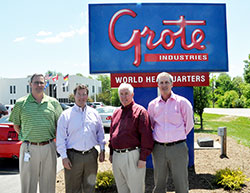 On May 22, a three-judge panel of the 7th U.S. Circuit of Appeals in Chicago heard arguments in a lawsuit filed by Grote Industries, a family-owned, worldwide manufacturer of vehicle lighting products in Madison.
On May 22, a three-judge panel of the 7th U.S. Circuit of Appeals in Chicago heard arguments in a lawsuit filed by Grote Industries, a family-owned, worldwide manufacturer of vehicle lighting products in Madison.
The Grote family argued that they should have relief from the “U.S. Department of Health and Human Services (HHS) mandate that forces most employers to provide abortion-inducing drugs, sterilizations and contraceptives to their employees in company health plans.”
The legal challenge is part of many across the country and is part of a nationwide campaign led by the U.S. bishops to fight for religious liberty. Rallies and calls to prayer occurred in the archdiocese throughout the year.
On Nov. 8, a ruling was handed down that gave the Grotes a victory.
“We hold that the plaintiffs—the business owners and their companies—may challenge the mandate,” U.S. Circuit Judge Diane Sykes wrote (emphasis in original). “We further hold that compelling them to cover these services substantially burdens their religious exercise rights.”
News coverage:
- Madison lawsuit
- Religious Freedom Events
Related:
6. The opening of a new medical school at Marian University in Indianapolis is a first for a Catholic college
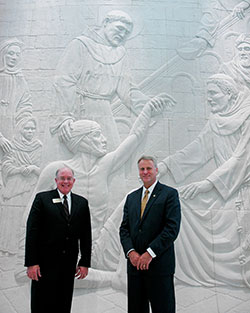 “Some people called it a ‘leap of faith’ when Marian University in Indianapolis announced its plan to be the first Catholic college in the country to have a school of osteopathic medicine,” wrote John Shaughnessy, Criterion assistant editor.
“Some people called it a ‘leap of faith’ when Marian University in Indianapolis announced its plan to be the first Catholic college in the country to have a school of osteopathic medicine,” wrote John Shaughnessy, Criterion assistant editor.
“Yet, Marian’s President Daniel Elsener prefers to use a different phrase as the university’s first group of 162 medical students gets ready for the historic first day of classes on Aug. 12.
“ ‘It’s a response to faith, a response to a call,’ Elsener said as he sat in the sparkling, $48 million, state-of-the-art Michael A. Evans Center for Health Sciences that is now the home of the university’s longtime nursing program and the second medical school in Indiana.”
The call Elsener referred to can be seen in recent studies that showed there could be a shortage of 2,000 primary care physicians in Indiana alone by 2020 if more doctors weren’t trained.
“We want to be a great Catholic university in a great American city for service to the world,” Elsener said. “To do that without resources is a pipe dream. So we say that if we want to be a great Catholic university, we have to have great resources, starting with a medical school.”
News coverage:
Related:
7. A record $3 million is raised to send children to Catholic schools
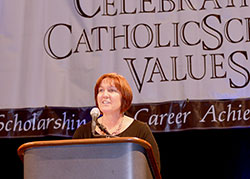 Each year, the archdiocese hosts the Celebrating Catholic Schools Values Awards event, honoring those with a commitment to Catholic education and raising money for schools.
Each year, the archdiocese hosts the Celebrating Catholic Schools Values Awards event, honoring those with a commitment to Catholic education and raising money for schools.
The previous record for money raised was $1.1 million in 2012. This year, the event nearly tripled that amount, raising $3 million to help children attend Catholic schools.
The $3 million was raised mostly through the Education CHOICE Charitable Trust for Tax Credit Scholarships, according to G. Joseph Peters, special consultant to the archdiocese’s Office of Catholic Education.
“Many things changed in the school choice laws this year, but the most important allowed for Tax Credit Scholarships to apply to income-eligible students already in our Catholic schools from kindergarten through 12th grade,” Peters said.
News coverage:
Related:
8. The Indiana voucher program is upheld in the courts and expanded by the legislature
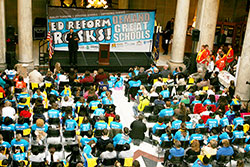 On March 26, the Indiana Supreme Court unanimously ruled that the state’s school voucher program was constitutional.
On March 26, the Indiana Supreme Court unanimously ruled that the state’s school voucher program was constitutional.
“I’m just really happy that Indiana’s constitution provides for and allows for parental choice,” said Glenn Tebbe, executive director of the Indiana Catholic Conference. “It complies with the Church’s understanding that parents are the first teachers, and have the right and responsibility to educate their children consistent with their values and their child’s educational needs.”
Statewide, the program—which is the nation’s broadest school voucher program—gave school vouchers to more than 9,300 students.
A day after the ruling, the state Senate approved House Bill 1003, a proposal to expand the voucher program.
News coverage:
Related:
9. Three men of diverse cultural background are ordained priests for the archdiocese
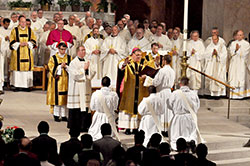 Three men were ordained priests for the archdiocese on May 18 during a Mass at SS. Peter and Paul Cathedral in Indianapolis: Fathers John Kamwendo, Douglas Marcotte and Martin Rodriguez.
Three men were ordained priests for the archdiocese on May 18 during a Mass at SS. Peter and Paul Cathedral in Indianapolis: Fathers John Kamwendo, Douglas Marcotte and Martin Rodriguez.
Each of the new priests comes from a different cultural background: Father Kamwendo is originally from Tanzania, Father Rodriguez grew up in Mexico, and Father Marcotte was raised a Hoosier.
At the ordination Mass, which was standing-room only (and streamed online), Archbishop Tobin gave advice to the new priests.
He said that they would “be able to speak to the hearts of your people only if you know their joys and sorrows, their anxiety and their hope.
“You must never let the burden of administration or the pursuit of your own interests deafen you to the cry of our sisters and brothers who, like you, search for God and hunger for God’s word,” Archbishop Tobin said.
News coverage:
Related:
10. Archbishop Tobin visits each of the 11 deaneries during his first months as archbishop
 Fulfilling a promise he made upon arriving in the archdiocese, Archbishop Tobin celebrated a series of Masses in each of the 11 deaneries during the first months of 2013.
Fulfilling a promise he made upon arriving in the archdiocese, Archbishop Tobin celebrated a series of Masses in each of the 11 deaneries during the first months of 2013.
The Masses were covered in a series of stories and photos in The Criterion.
An estimated 1,000 people attended a Jan. 29 Mass at St. Mary-of-the-Knobs Church in Floyd County. “I thought that Hoosier hospitality was just a bumper sticker,” Archbishop Tobin told those gathered, “but it’s the real thing.”
Henry Andres, a lifelong member of St. Mary-of-the-Knobs Parish, called the new archbishop “awesome. He’s on our level. I think he’s someone we can talk to.”
The archbishop said that he was energized by the Masses and the welcome he received, and was struck by what he called the “anomalous location of the cathedral.”
“I don’t think that I will forget that there’s a lot of the archdiocese outside of Indianapolis,” he said. “I wouldn’t want them to feel like there’s Indianapolis and, as an afterthought, there’s the rest of us.”
News coverage:
Related:


 It’s no small feat to play host to more than 23,000 high school-aged Catholics from all over the country for a weekend. It’s even more impressive that this is the second time in the past two years that Indianapolis has hosted the biannual National Catholic Youth Conference (NCYC).
It’s no small feat to play host to more than 23,000 high school-aged Catholics from all over the country for a weekend. It’s even more impressive that this is the second time in the past two years that Indianapolis has hosted the biannual National Catholic Youth Conference (NCYC).






